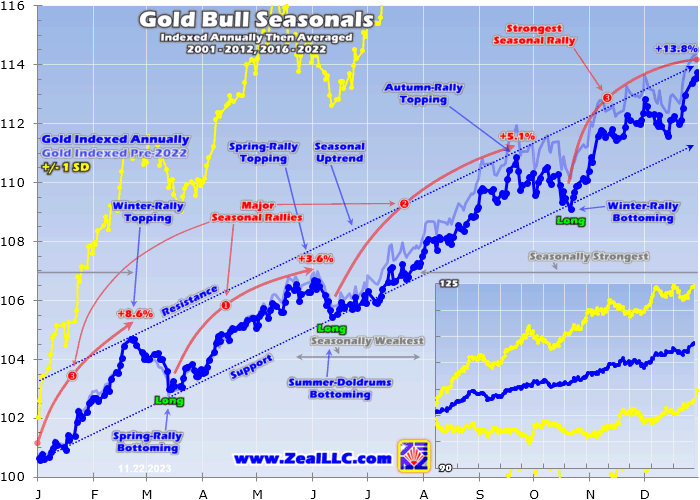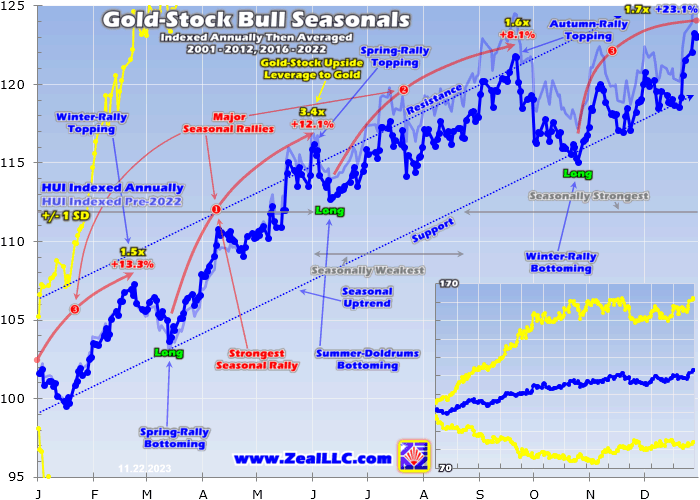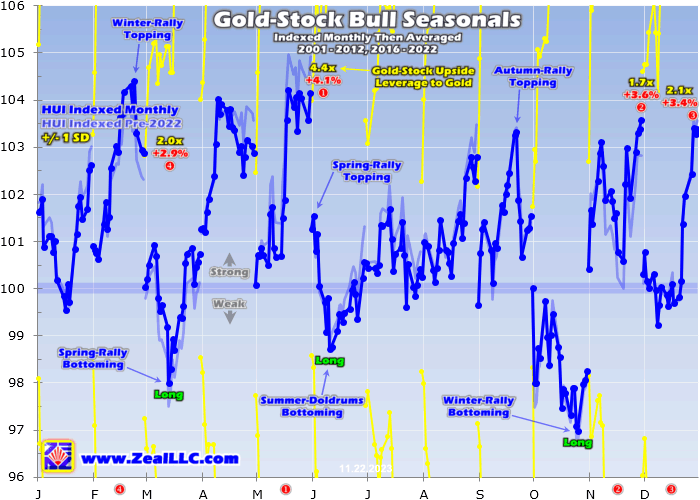Gold stocks have mostly ground lower to sideways since spring, leaving this contrarian sector really out of favor again. Yet both the metal and its miners’ stocks are early on in their strongest seasonal rallies of the year. From late October to late February, gold tends to enjoy excellent gains which the gold stocks leverage. Given 2023’s great winter-rally setup, gold’s bullish seasonals should prove potent tailwinds ahead.
Seasonality is the tendency for prices to exhibit recurring patterns at certain times during the calendar year. While seasonality doesn’t drive price action, it quantifies annually-repeating behaviors driven by sentiment, technicals, and fundamentals. We humans are creatures of habit and herd, which naturally colors our trading decisions. The calendar year’s passage affects the timing and intensity of buying and selling.
Gold stocks display strong seasonality because their price action amplifies that of their dominant primary driver, gold. Gold’s seasonality generally isn’t driven by supply fluctuations like grown commodities see, as its mined supply remains relatively steady year-round. Instead gold’s major seasonality is demand-driven, with global investment demand varying considerably depending on the time in the calendar year.
This gold seasonality is fueled by well-known income-cycle and cultural drivers of outsized gold demand from around the world. And the biggest seasonal surge of all is just getting underway heading into winter. As the Indian-wedding-season gold-jewelry buying that normally drives this metal’s big autumn rally winds down, the Western holiday season ramps up. The holiday spirit puts everyone in the mood to spend money.
Men splurge on vast amounts of gold jewelry for Christmas gifts for their wives, girlfriends, and daughters. The holidays are also a major engagement season, with Christmas Eve and New Year’s Eve being two of the biggest proposal nights of the year. Something like a third to half of the entire annual sales of many jewelry retailers come in November and December! And jewelry historically dominates overall gold demand.
The World Gold Council closely tracks global gold supply and demand, publishing the latest data each quarter. During the last five calendar years, jewelry demand averaged 42.7% of overall total world gold demand. That is much larger than investment demand, which averaged 26.6% during that same 2018-to-2022 span. Year-to-date in 2023 at the end of Q3, jewelry demand is tracking at a similar 42.9% of the total.
The usual frenzied Western jewelry buying heading into Christmas shifts to pure investment demand after year-end. That’s when Western investors figure out how much surplus income they earned during the prior year after bonuses and taxes. Some of this is plowed into gold in January, driving it higher. Finally gold’s big winter rally climaxes in late February on major Chinese New Year gold buying flaring up in Asia.
So during its bull-market years, gold has usually tended to enjoy powerful winter rallies driven by these sequential episodes of outsized demand. Naturally the gold stocks follow gold higher, amplifying its gains due to their excellent profits leverage to the gold price. Today gold stocks are now once again early on in gold’s strongest seasonal rally of the year, driven by this annually-recurring robust winter gold demand.
Since it is gold’s own demand-driven seasonality that fuels gold stocks’ seasonality, that’s logically the best place to start to understand what’s likely coming. This old research thread focuses on modern bull-market seasonality, as bull and bear price action are quite different. Gold enjoyed a mighty 638.2% bull run from April 2001 to August 2011, fueling gold stocks skyrocketing 1,664.4% per their leading index then!
Following that secular juggernaut, gold consolidated high then started correcting into 2012. But the yellow metal didn’t enter formal bear territory down 20%+ until April 2013. That beast mauled gold on and off over several years, so 2013 to 2015 are excluded from these seasonal averages. Gold finally regained bull status powering 20%+ higher in March 2016, then its gains grew to a modest 96.2% by August 2020.
Another high consolidation emerged after that, where gold avoided relapsing into a new bear despite a serious correction. Later the yellow metal started powering higher again, coming within 0.5% of a new nominal record in early March 2022 after Russia invaded Ukraine. So 2016 to 2021 definitely proved bull years too, with 2022 really looking like one early on. Then Fed officials panicked, unleashing market chaos.
Inflation was raging out of control thanks to their extreme money printing. In just 25.5 months following the March 2020 pandemic-lockdown stock panic, the Fed ballooned its balance sheet an absurd 115.6%! That effectively more than doubled the US monetary base in just a couple years, injecting $4,807b of new dollars to start chasing and bidding up the prices on goods and services. That fueled an inflation super-spike.
With big inflation running rampant, Fed officials frantically executed the most-extreme tightening cycle in this central bank’s history. They hiked their federal-funds rate an astounding 450 basis points in just 10.6 months, while also selling monetized bonds through quantitative tightening! That ignited a huge parabolic spike in the US dollar, unleashing massive gold-futures selling slamming gold 20.9% lower into early September.
That was technically a new bear market, albeit barely and driven by an extraordinary anomaly that was unsustainable. Indeed gold soon rebounded sharply, exiting 2022 with a trivial 0.3% full-year loss. Gold kept on powering higher, reentering bull territory up 20.2% in early February 2023! So I’m also classifying 2022 as a bull year for seasonality research. Gold’s modern bull years include 2001 to 2012 and 2016 to 2023.
Prevailing gold prices varied radically across these secular spans, running just $257 when gold’s mighty 2000s bull was born to August 2020’s latest record high of $2,062. That vast range of gold levels spread over all those long years has to first be rendered in like-percentage terms in order to make them perfectly comparable with each other. Then they can be averaged together to distill out gold’s bull-market seasonality.
That’s accomplished by individually indexing each calendar year’s gold price action to its final close of the preceding year, which is recast at 100. Then all gold price action of the following year is calculated off that common indexed baseline, normalizing all years. So gold trading at 110 simply means it has rallied 10% off the prior year’s close. Gold’s previous seasonality before 2022 was added is shown in light blue.

During fully 19 of the last 22 years, gold has averaged excellent 13.8% annual gains! This great recent-decade track record should leave gold widely respected as an essential portfolio diversifier. All investors should deploy some small fraction of their financial assets into gold, like the traditional 5% to 10% which was considered prudent for centuries. Gold allocations stabilize returns, while protecting against market shocks.
Gold’s hefty modern-bull-year seasonal gains mostly accrued in three distinct rallies, autumn, winter, and spring ones. They respectively averaged 5.1%, 8.6%, and 3.6% gains during this secular span. While all are worth riding, gold’s winter rally is easily the seasonal champion sporting the biggest upside. Surging 8.6% higher in just 4.1 months annualizes near a fast 25% rallying pace! Gold’s winter rally is quite powerful.
Again it is usually born around late October, where gold has already averaged 9.1% year-to-date gains. This year’s winter-rally bottoming proved different, pulled earlier and lower by a monster bear rally in the US Dollar Index on expectations for more Fed rate hikes. While gold’s pre-winter-rally seasonal low averages October’s 16th trading day, this year it arrived on the 4th. Gold was also more battered than usual.
Thanks to more heavy gold-futures selling in reaction to that soaring US dollar, the yellow metal actually drooped to a slight 0.2% YTD loss! But more-oversold lower lows herald bigger mean-reversion-rebound rallies, and this underway winter one is no exception. Igniting from geopolitical fears then largely fueled by slipping Fed rate expectations, gold blasted up 10.2% in just a few weeks! This winter rally is already big.
That sharp symmetrical V-bounce left gold up a more-normal-for-this-time-of-year 9.9% YTD. While such gains already exceeded the winter-rally average, that doesn’t mean this year’s seasonal run prematurely exhausted itself. Gold suffered an unusual breakdown leading into early October, plunging 5.8% over just 12 trading days after hawkish FOMC officials upped their year-end-2024 forecast for the federal-funds rate.
Interestingly fully 6/10ths of gold’s strong winter rally since was just regaining that lost technical ground! Had those aggressive FOMC dots not blindsided gold, its winter-rally bottoming in 2023 would have likely proven considerably higher. Maybe closer to $1,900 than that distorted $1,820 nadir. With the majority of this winter rally’s surge being a mean-reversion bounce out of an anomalous breakdown, it doesn’t look mature.
These winter-rally averages yield gold upside targets. An 8.6% average gain from early October’s deep low would merely leave gold near $1,976, under current levels. That would be disappointing, implying gold would just grind sideways on balance into late February. But if that early-October selloff anomaly that quickly reversed is ignored, from a more-normal $1,900 bottoming an 8.6% seasonal surge yields $2,063.
That sure makes for a powerful level psychologically. Gold’s nominal all-time-record closing high was again $2,062 in early August 2020. This newest winter rally could easily push gold to the verge of forging into record territory. Gold nearing, challenging, and achieving new records will win widespread financial-media coverage stoking soaring popular bullishness and greed! Investors will flock back to chase those gains.
These guys generally ignore gold until it surges long enough and high enough to recapture their attention. Then they rush to buy to ride that upside momentum, amplifying gold’s gains with their massive capital inflows. So if this young winter rally boosts gold near record territory, it will almost certainly mushroom outsized before giving up its ghost. There’s another average-winter-rally target even more bullish for gold.
These seasonal winter rallies run from late in years to early in subsequent ones. Across all these modern gold-bull years, on average winter rallies peaked 18.5% above gold’s final closes entering the first years. Think of this as a year-to-date measure extended into the second years when winter rallies crest. Gold climbing 18.5% above its year-end-2022 levels yields an average-winter-rally target way up at $2,161!
These absolute levels aren’t the point here, they can never be precisely predicted. But it’s important to realize this young 2023 seasonal winter rally lifting gold to new nominal records in coming months isn’t a stretch at all. And that will change everything psychologically for gold, quickly shifting herd sentiment back to very-bullish. Gold will be impossible to ignore as new records generate excited financial-media hype.
Major price trends are driven by sentiment, technicals, and fundamentals, not seasonals. But when the former three prime movers are pushing gold higher, strong seasonals act like nice tailwinds ballooning those gains. The dominant bullish case for gold today is speculators’ bearish positioning in gold futures, which will require massive buying to normalize. My recent essay on gold’s new major upleg analyzed that in depth.
Bullish seasonals are simply the icing on the cake, not necessary but nice to have to enhance in-progress uplegs. And if gold hitting new record closes soon gets speculators and investors excited, demand for unloved gold stocks will skyrocket. They will follow their metal higher like usual, really amplifying its gains. Gold stocks also tend to see solid winter rallies thanks to gold’s, their strongest seasonal time of the year.
Gold miners’ stocks will be the biggest beneficiaries of a record-supercharged gold winter rally. This next chart applies this same modern-gold-bull-year seasonality methodology to gold stocks. Since GDX was born later in May 2006, its price history is insufficient for longer-term studies. Thus the classic HUI gold-stock index is used instead. Closely tracking each other, GDX and the HUI are functionally interchangeable.

The major gold stocks enjoy parallel seasonal autumn, winter, and spring rallies mirroring and leveraging gold’s. Those averaged solid 8.1%, 13.3%, and 12.1% gains during these same 19 modern gold-bull years. That made for respective upside leverage to gold of 1.6x, 1.5x, and 3.4x. It also helped the HUI achieve big average annual gains of 23.1% over this long secular span! Gold stocks have proven major winners.
Like gold, the gold stocks’ winter rallies begin in late October then run into late February. This gold-stock surge starts a few trading days after gold’s, but ends at the same time. This year’s pre-winter-rally low came a few weeks earlier than usual, forced by gold’s anomalous post-FOMC plunge. Slammed to its own very-oversold unsustainable low, GDX’s initial mean-reversion rebound was symmetrically sharp and violent.
In the first couple weeks after that gold-futures-selling-driven winter-rally bottoming, GDX blasted up 14.0% amplifying gold’s own 5.6% V-bounce by 2.5x. That was right in the middle of major gold stocks’ normal leverage range to material gold moves of 2x to 3x. But over the next couple weeks or so as gold continued surging, GDX fell way behind. By the time gold had recovered 10.2%, GDX had merely rallied 12.7%.
That’s really poor, gold stocks have to leverage their metal to compensate traders for the major additional risks they bear. I analyzed why gold stocks were lagging in another essay a few weeks ago. The general stock markets falling sharply in that span contributed, universally tainting sentiment. Bearishness surged on that, leaving traders less willing to add any stock trades. But gold-stock performance is also just lumpy.
Gold stocks tend to surge then drift, advance sharply then retreat some to consolidate those gains. This is even evident in the winter-rally seasonals in this chart. Gold stocks’ outperformance to gold also tends to grow as gold uplegs mature. Early on traders are skeptical about their staying power, so they remain reluctant to add gold stocks. But the longer and higher gold runs, the more attractive gold stocks become.
So disproportional gold-stock buying tends to occur later in major gold uplegs as popular greed flares. That often leads leverage to gold to improve considerably as gold uplegs age. GDX could easily end up amplifying gold’s mounting winter rally closer to 3x in the coming months. Gold’s new record highs will help drive that, greatly increasing sector interest and bullishness. Great gold-stock fundamentals will help.
Last week I analyzed the GDX-top-25 gold miners’ latest Q3’23 results. The were fantastic, making for one of the best quarters gold stocks ever reported. Lower mining costs combined with higher gold prices led sector unit earnings to nearly double! Revenues, profits, and operating cash flows were strong, and this trend is likely to continue. Better earnings drive down valuations and attract back institutional investors.
To hit that $2,161 winter-rally target in late February, gold’s new upleg would only have to grow to 18.8% gains. That’s fairly modest, as its last upleg cresting in early May soared 26.3%. If gold rallied around 19%, the GDX gold stocks ought to double to triple that at 38% to 57% winter-rally gains! Right in the middle at 2.5x leverage would leave GDX near $38.25 in a few months, which would be well worth riding.
Traders tend to warm to gold stocks in coming winter months, as this final chart slicing gold-stock seasonals into calendar months shows. Each is indexed to 100 at the previous month’s final close, then all like months’ indexes are averaged together across these same modern-gold-bull years. Together November, December, January, and February have long proven this sector’s strongest cluster of big seasonal gains.

During these four winter-rally months, the HUI has averaged strong 3.6%, 3.4%, 2.6% and 2.9% gains in these modern-gold-bull years. November, December, and February rank as the 2nd, 3rd, and 4th best calendar months for gold-stock seasonal gains! While May is stronger up 4.1% on average, no other seasonal span rivals the winter rally’s grouping of big up months. Outsized rallies are likely this time of year.
The closer gold advances to new record territory, the more popular bullishness will mount. As sentiment improves, interest in the battered gold stocks should soar. While the larger majors of GDX should amplify gold’s upside by 2x to 3x, smaller mid-tiers and juniors ought to really outperform. Our newsletter trading books are full of fundamentally-superior ones, better able to consistently grow their production off littler bases.
Successful trading demands always staying informed on markets, to understand opportunities as they arise. We can help! For decades we’ve published popular weekly and monthly newsletters focused on contrarian speculation and investment. They draw on my vast experience, knowledge, wisdom, and ongoing research to explain what’s going on in the markets, why, and how to trade them with specific stocks.
Our holistic integrated contrarian approach has proven very successful, and you can reap the benefits for only $10 an issue. We extensively research gold and silver miners to find cheap fundamentally-superior mid-tiers and juniors with outsized upside potential. Sign up for free e-mail notifications when we publish new content. Even better, subscribe today to our acclaimed newsletters and start growing smarter and richer!
The bottom line is gold and thus gold stocks are early on in their strongest seasonal rallies of the year. Gold’s big winter rally is fueled by outsized demand first from holiday jewelry buying, then later new-year investment buying. That has long helped drive the metal and its miners’ stocks considerably higher from late October to late February. And 2023’s young winter rally has great potential to grow much bigger than usual.
Gold is forging towards nominal all-time-record territory again for the first time in several years. As gold nears, challenges, and achieves new records, bullish financial-media coverage will soar helping to entice back legions of investors. The longer and higher gold runs, the more they’ll rush to chase its gains amplifying them. Meanwhile gold miners’ earnings are soaring, leaving their stocks even more undervalued.
Adam Hamilton, CPA
November 24, 2023
Copyright 2000 - 2023 Zeal LLC (www.ZealLLC.com)

